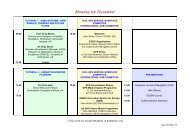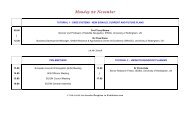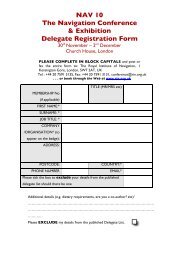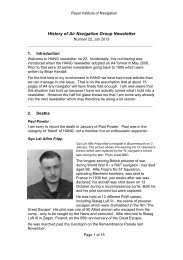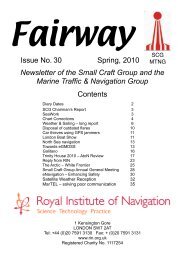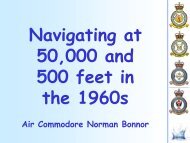HANG Newsletter - Royal Institute of Navigation
HANG Newsletter - Royal Institute of Navigation
HANG Newsletter - Royal Institute of Navigation
Create successful ePaper yourself
Turn your PDF publications into a flip-book with our unique Google optimized e-Paper software.
<strong>Royal</strong> <strong>Institute</strong> <strong>of</strong> <strong>Navigation</strong><br />
crossing), this surprising military manoeuvre was both bold and desperate and<br />
has inspired countless readers <strong>of</strong> ancient history in the intervening millennia.<br />
Because it was undertaken in late fall – which is early winter in these high<br />
Alps – the Pleiades constellation could be easily viewed at a certain recorded<br />
point in the night sky, a journey that would have been daunting even in the<br />
summer became all the more dramatic. As Polybius wrote:<br />
"After a journey <strong>of</strong> nine days, Hannibal gained the summit pass. He camped<br />
there and stayed for two days to rest the survivors <strong>of</strong> his army and wait for<br />
stragglers...As it was now almost the time for the setting <strong>of</strong> the Pleiades, snow<br />
had already settled on the summit...He noticed that his men were in a state <strong>of</strong><br />
low morale for all that they had suffered and tried to cheer them up. He<br />
depended on the actual view <strong>of</strong> Italy, which lies so close under these<br />
mountains that when they are seen together, the Alps stand to Italy in the<br />
same way a citadel does to a city...He restored their spirits by showing them<br />
the plain <strong>of</strong> the Po..."<br />
Unfortunately, the specific name <strong>of</strong> the pass Hannibal used was never<br />
mentioned in any sources or presumably by the informant who may never<br />
have known its Celtic name anyway. Some <strong>of</strong> the Celts aided Hannibal and<br />
his Punic and mercenary army with guides and provisions; others were hostile<br />
and some may have tried to lead him into an Alpine trap, from which he<br />
escaped by clever resources and brave fortitude at some expense <strong>of</strong> men,<br />
animals and supplies to the surprise <strong>of</strong> both Celts and Romans.<br />
The Stanford Alpine Archaeology Project has attempted to track Hannibal<br />
since 1994, using near contemporary sources like Polybius (c150 BC) who<br />
claimed his informant’s account was directly compiled from one <strong>of</strong> Hannibal’s<br />
veterans who would have been very young during the march. Livy used<br />
Polybius and other possible sources nearly two centuries later.<br />
Livy adds some accurate comments about the improbability <strong>of</strong> some <strong>of</strong> the<br />
<strong>of</strong>ten-suggested northern Hannibal routes such as the Grand-St-Bernard pass<br />
then known as Poeninus. This route would have added far too many days to<br />
Hannibal's journey being so far northward and requiring Hannibal to travel all<br />
the way around Lac Leman (Lake Geneva).<br />
Our Stanford team has hiked over at least 15 Alpine passes, many on multiple<br />
occasions, and compared their present landmark features to the topographic<br />
details given in Polybius and Livy. Allowing for a modicum <strong>of</strong> some erosional<br />
and geomorphological change, it is still possible to find a few favourable<br />
candidates among the western Alpine passes (now between France and Italy)<br />
and at the same time eliminate many more passes as unsuitable based on the<br />
ancient historians’ narratives.<br />
Naturally, this also rests on several assumptions: that the informants <strong>of</strong><br />
Polybius and others were accurate observers and honest in their recollections<br />
and that Hannibal himself was fairly well-informed (when not misinformed by<br />
Celts) and honest with his soldiers when he is reported to have made<br />
geographical statements. The most recent phase <strong>of</strong> the Stanford Alpine<br />
Archaeology Project's Hannibal route research is published in a new book<br />
Alpine Archaeology (2007).<br />
Page 9 <strong>of</strong> 16




